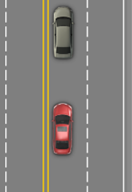Lesson Three: Managing Space and Judging Time (4.3)
In previous chapters, you have learned how to search, identify, and target the space ahead of you. Knowing what is happening around you as you drive helps you make decisions about speed, lane position, and communication options.
Managing risk with SIM includes following distance. Maintaining an adequate following distance allows you to see restrictions ahead and respond in enough time to adjust your speed or lane position. Failing to maintain adequate following distance removes your control over the situation. You cannot respond; you can only react.
The minimum following distance is _______ seconds.
When at highway speeds, with vision restrictions, on slick roads, and behind motorcycles and/or large trucks, increase to _________ seconds.
 Following Distance
Following Distance
 Managing space helps you reduce risk. There is a point at which you will no longer be able to stop safely if something changes. This is called the point of no return. Two seconds away from any situation or object e.g. door opening on a parked vehicle, intersection, yellow traffic signal, pedestrian crossing between parked vehicles, traffic pulling out or stopping in front of you, cyclist, or stopped traffic.
Managing space helps you reduce risk. There is a point at which you will no longer be able to stop safely if something changes. This is called the point of no return. Two seconds away from any situation or object e.g. door opening on a parked vehicle, intersection, yellow traffic signal, pedestrian crossing between parked vehicles, traffic pulling out or stopping in front of you, cyclist, or stopped traffic.
Following too close creates problems for drivers. What are some problems that can be encountered when following too close?

 Point of No Return
Point of No Return
Closure
Closure rate is the rate at which you are getting closer to the vehicle ahead, the space is getting smaller, decreasing. The vehicle ahead is not going the same speed as you. Recognizing closure rate early allows you to maintain your following distance without late braking.
Essential Questions
-
What are the benefits of managing space and judging time?
-
Where is the point of no return and how does it impact our driving decisions?
-
How do you create, maintain and/or rebuild sufficient following distance?
The amount of time/space between vehicles when following another vehicle in the intended path of travel to avoid conflict.
Limit your ability to gather information about the condition of your
intended path.
Chance of injury, damage, or loss. In driving, risk (potential or immediate) is the possibility of having a conflict that results in a crash or collision.
Point beyond which a driver can no longer stop safely without entering the intersection or space.